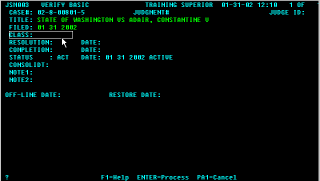SCOMIS Manual[Return to Codes TOC]
Usage Notes The Class codes are used on the Basic screen for a Juvenile Offender case. Refer to the Superior Court Statistical Reporting Manual for detailed information on Juvenile Offender reporting categories and class codes. Click image to enlarge; use the browser back button to return
MIS, GMS, FEL - For juvenile offender cases in which there are criminal charges to be adjudicated, use the Class code which reflects the severity of the most serious charge on the original information filed.
Transfers for Sentencing - A case that was adjudicated in another county and is transferred to the receiving county for sentencing. The receiving county files the case in JIS and enters a class code TSN on the SCOMIS Basic screen. The case is resolved at filing with UNDS (uncontested resolution), since all charges have been adjudicated by the sending county. All charges that have a guilty result from the final information on the transferred case are recorded on the SCOMIS Charge screen by the receiving county with a result code of TR. After filing, record hearing and sentencing information, and complete the case as usual. On the Caseload Report, the filing and resolution of a transfer for sentencing case is counted under the non-charge category for the receiving county. Proceedings held and sentencing are counted as in other offender cases, based on the most serious charge at the time of the event. Transfers for Supervision - A case that was adjudicated and sentencing occurred in another county and is transferred by court order to the receiving county for supervision and monitoring. The receiving county files the case in JIS and enters a class code of TSV on the SCOMIS Basic screen. The case is resolved at filing with UNDS (uncontested resolution) since all charges have been adjudicated by the sending county. The case is completed at filing with CPFD (completed when filed) since sentencing has already occurred. All charges that have a guilty result from the final information on the transferred case are recorded on the SCOMIS Charge screen by the receiving county with a result code of TR. All information on these transferred for supervision cases will be counted under the non-charge category on the Caseload Report.. Non-Charge- A non-charge case is one in which the defendant/respondent is not charged under any state criminal statutes, but which is opened for purposes such as extradition, material witness, or preliminary appearances prior to filing of an information. The Class code NON is entered on the SCOMIS Basic screen. On the SCOMIS Charge screen a non-charge RCW code is recorded. A non-charge has a statistical reporting code of 00 and a statistical category of N. Refer to the RCW codes for a detailed listing of non-charges. A non-charge case should not be opened to record a search warrant, wiretap authorization, or other non-respondent document(s); record these documents in the Document Indexing application. If an information is not filed, record a Result code N for each non-charge entry, then resolve and complete the case. Any proceedings held will be counted under the non-charge category on the Caseload Report. If an information is subsequently filed, change the Charge record to correspond to the new information including the original information filing date, the RCW(s), the DV flag, and the violation date. On the SCOMIS Basic screen, change the case filing date to the date on which the information was filed. For a juvenile offender case, change the Class code from NON to MIS, GMS, or FEL to reflect that criminal charges are to be adjudicated. The case will be counted in the Caseload Report as of the date the information is filed. Any proceedings held prior to the filing of an information will be counted under the non-charge category on the Caseload Report |
||||||||||||||||||||||||||||||




Privacy and Disclaimer Notices Sitemap
© Copyright 2025. Washington State Administrative Office of the Courts.
S3

